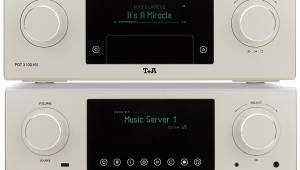Panasonic Dmp Bd50 (£450)
Convergence between national markets is fueling the development of new, one-size-fits-all AV products at an unprecedented pace, often reducing shelf life to a few short months. New BD players are a case in point. Such is the pace of technology, and the scramble to patch both HDMI and Profile standards, that no sooner had we completed our review of Panasonic’s DMP-BD30 Blu-ray player than its replacement, the DMP-BD50, was announced. So one review was shelved and another immediately instigated. Let’s just hope the ink dries on this page before the DMP-BD70 is unveiled...
Appearances alone do little to separate the slim chassis, mirrored drop-down fascia, HDMI and 5.1 channel connectivity of either model. In practice it’s all about an update in Blu-ray ‘Profile’ from 1.1 to 2.0 in this latest DMP-BD50 version [see boxout, below]. Otherwise, both players rely upon the same PHL (Panasonic Hollywood Laboratory) ‘Reference Chroma Processor’ running, presumably, very slightly different iterations of Panasonic’s P4HD imaging firmware.
UNIFICATION THEORY
Dubbed ‘UniPhier’, this core processor unpacks MPEG2, MPEG4, H.264, VC1 and WMV9 video datastreams with de-interlacing, chroma processing, noise reduction options and scaling accommodating 15 billion pixels per second along with full DRM (Digital Rights Management). The ’BD50 decodes DTS-HD Master Audio and DTS-HD High Resolution Audio along with Dolby TrueHD with support for up to 9.1 LPCM audio channels. In practice, both Panasonic players are limited to 5.1 audio channels from their analogue outputs while delivering multichannel LPCM, Dolby and DTS HD bitstreams via the HDMI 1.3 connection.
As expected these days, the HDMI connection offers scaled video outputs from 480p up to 1080/60p and 1080/24p (although, along with other menu functions this cannot be adjusted on-the-fly), the latter delivering original movie content without any frame-rate conversion. Panasonic has also improved its BD loading times but until standalone players adopt DSP comparable to the powerful 64-bit PowerPC core of Sony’s CELL processor (used in its PS3), the interminable wait for Java-based menu screens from, typically, Disney BD releases like the Pirates... series and Ratatouille remains excrutiating.
RE-MASTER RETURNS
As far as the audio/home theatre enthusiast is concerned, the underlying sound and picture performance of both the DMP-BD30 and ’BD50 is nigh-on identical, not least because both players use the same core audio/video processor, eight-channel DAC and HDCP/HDMI driver. As expected, the players make a far better fist of handling Blu-ray media than either CD or DVD and the best sound quality is undoutedly achieved via an S/PDIF or HDMI link to an outboard DAC or AV receiver. All internal audio is subject to Panasonic’s ‘Re-Master’ processing designed to ‘compensate for data lost in the compression process used in Blu-ray disc and DVD recording’ even, it seems, when that audio data is linear PCM from CD, DVD or Blu-ray [see Lab Report].
Even with ‘Re-Master’ apparently defeated from Panasonic’s ‘Sound Effects’ menu, some of the snap, crackle and pop of Southside Johnny’s live Grapefruit Moon CD [GELM 4200] was still softened, I assume, by the warm milk of Panasonic’s DSP and yet the same tracks – ‘Down, Down, Down’ and ‘All the Time in the World’ – possessed more energy when replayed via HDMI into the same AV receiver (Pioneer’s ‘Susano’ SC-LX90 – full review next month). The same is generally true of LPCM, Dolby TrueHD/DTS-HD Master Audio or even Dolby Digital bitstreams delivered by Blu-ray. The Pat Metheny group’s The Way Up – Live transfered to BD provides a good test of multichannel atmosphere, hinted at but not fully resolved by the ’BD50 even if the 1080p imagery looked positively stunning.
In similar fashion, if you want to experience the cutting-edge soundtrack that accompanies Bond’s chase scene through the construction site in Casino Royale or even the resonance of Will Smith’s Shelby as he roams the empty streets of Manhattan in I Am Legend, then it’s HDMI all the way. The next step in performance is just sitting there waiting to be discovered once Panasonic and other manufacturers adopt a synchronising clock over the HDMI link, reducing digital jitter at a stroke. In my estimation, this particular innovation will soon be upon us.
LIGHTS OUT
Running native 1080/24p digital video from Blu-ray into both Pioneer’s latest G9 plasma and KRF-9000FD projector found the DMP-BD50 at its very finest. Primary colours from animated material like Cars have a dense impact while pastel hues reflect the colour cast chosen, typically during production, to enhance the movie’s overall ambience. Recent releases, including Warner’s I am Legend looked superb, the change in visual atmosphere between the flashback sequencies and desolation of his present day were etched in sharp relief. In a high-end application, its resolution was more than sufficient to expose the real shots of a closed-off 5th Avenue decorated with grubby-looking vehicles and long grasses versus those images tickled-up with CGI.
Similarly, the grit and grain added to Black Hawk Down is revealed by the ’BD50 with all the subtlety of the director dragging his fingernails down a chalkboard. The same movie delivered via SuperBit DVD is less impressive, however, as grain is traded for a slight shimmer where it overlays finely-patterned brickwork. In this instance a dedicated, but rather costlier DVD player like Denon’s tried-and-tested DVD-A1XV renders this same DVD with greater apparent detail and subtlety. Frankly, I’ve yet to discover a Blu-ray player that’s all things to all formats, but I live in hope!
VERDICT
The hold-outs need hold out no longer as HDMI 1.3 digital audio/video streaming and Profile 2.0 functionality converge in this ‘final generation’ Blu-ray player from Panasonic. It’s not the best DVD player on the planet but Blu-ray media looks and sounds fabulous via the HDMI connection. And it’s available at a fraction the price of any display technology likely to do it full justice.
Originally published in the October 2008 issue





















































